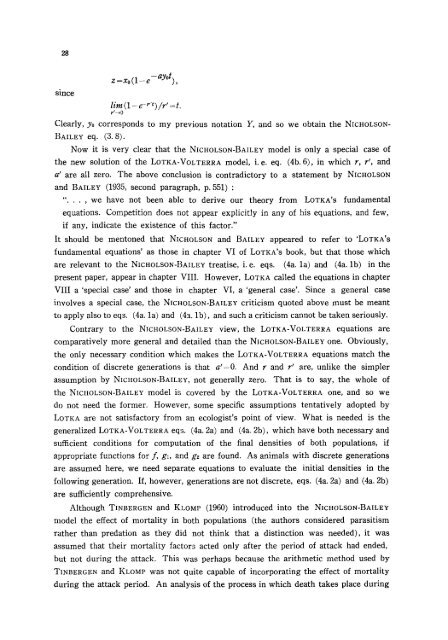A comparative study of models for predation and parasitism
A comparative study of models for predation and parasitism
A comparative study of models for predation and parasitism
Create successful ePaper yourself
Turn your PDF publications into a flip-book with our unique Google optimized e-Paper software.
28<br />
since<br />
z =Xo (1 - e-ay~<br />
lira (1 - e-,'t)/r': t.<br />
r~-~O<br />
Clearly, y0 corresponds to my previous notation Y, <strong>and</strong> so we obtain the NICHOLSON-<br />
BAILEY eq. (3. 8).<br />
Now it is very clear that the NICHOLSON-BAILEY model is only a special case <strong>of</strong><br />
the new solution <strong>of</strong> the LOTKA-VOLTERRA model, i.e. eq. (4b. 6), in which r, r', <strong>and</strong><br />
a' are all zero. The above conclusion is contradictory to a statement by NICHOLSON<br />
<strong>and</strong> BAILEY (1935, second paragraph, p. 551) :<br />
"... , we have not been able to derive our theory from LOTKA'S fundamental<br />
equations. Competition does not appear explicitly in any <strong>of</strong> his equations, <strong>and</strong> few,<br />
if any, indicate the existence <strong>of</strong> this factor."<br />
It should be mentoned that NICHOLSON <strong>and</strong> BAILEY appeared to refer to 'LOTKA'S<br />
fundamental equations' as those in chapter VI <strong>of</strong> LOTKA'S book, but that those which<br />
are relevant to the NICHOLSON-BAILEY treatise, i.e. eqs.<br />
(4a. la) <strong>and</strong> (4a. lb) in the<br />
present paper, appear in chapter VIII. However, LOTKA called the equations in chapter<br />
VIII a 'special case' <strong>and</strong> those in chapter VI, a 'general case'. Since a general case<br />
involves a special case, the NICHOLSON-BAILEY criticism quoted above must be meant<br />
to apply also to eqs. (4a. la) <strong>and</strong> (4a. lb), <strong>and</strong> such a criticism cannot be taken seriously.<br />
Contrary to the NICHOLSON-BAILEY view, the LOTKA-VOLTERRA equations are<br />
<strong>comparative</strong>ly more general <strong>and</strong> detailed than the NICHOLSON-BAILEY one. Obviously,<br />
the only necessary condition which makes the LOTKA-VOLTERRA equations match the<br />
condition <strong>of</strong> discrete generations is that a'-0.<br />
And r <strong>and</strong> r' are, unlike the simpler<br />
assumption by NICHOLSON-BAILEY, not generally zero. That is to say, the whole <strong>of</strong><br />
the NICHOLSON-BAILEY model is covered by the LOTKA-VOLTERRA one, <strong>and</strong> so we<br />
do not need the <strong>for</strong>mer. However, some specific assumptions tentatively adopted by<br />
LOTKA are not satisfactory from an ecologist's point <strong>of</strong> view. What is needed is the<br />
generalized LOTKA-VOLTERRA eqs. (4a. 2a) <strong>and</strong> (4a. 2b), which have both necessary <strong>and</strong><br />
sufficient conditions <strong>for</strong> computation <strong>of</strong> the final densities <strong>of</strong> both populations, if<br />
appropriate functions <strong>for</strong> f, gl, <strong>and</strong> gz are found. As animals with discrete generations<br />
are assumed here, we need separate equations to evaluate the initial densities in the<br />
following generation. If, however, generations are not discrete, eqs. (4a. 2a) <strong>and</strong> (4a. 2b)<br />
are sufficiently comprehensive.<br />
Although TINBERGEN <strong>and</strong> KLOMP (1960) introduced into the NICHOLSON-BAILEY<br />
model the effect <strong>of</strong> mortality in both populations (the authors considered <strong>parasitism</strong><br />
rather than <strong>predation</strong> as they did not think that a distinction was needed), it was<br />
assumed that their mortality factors acted only after the period <strong>of</strong> attack had ended,<br />
but not during the attack. This was perhaps because the arithmetic method used by<br />
TINBERGEN <strong>and</strong> KLOMP was not quite capable <strong>of</strong> incorporating the effect <strong>of</strong> mortality<br />
during the attack period. An analysis <strong>of</strong> the process in which death takes place during















